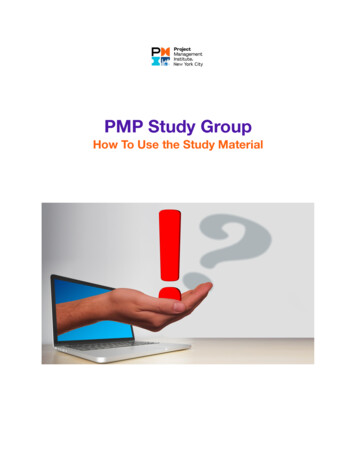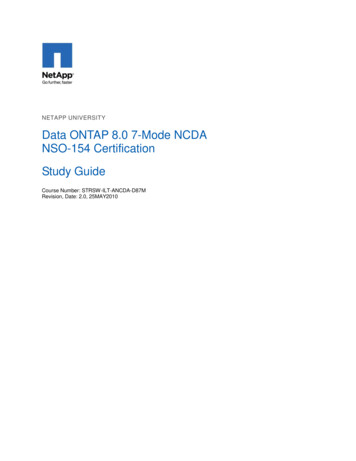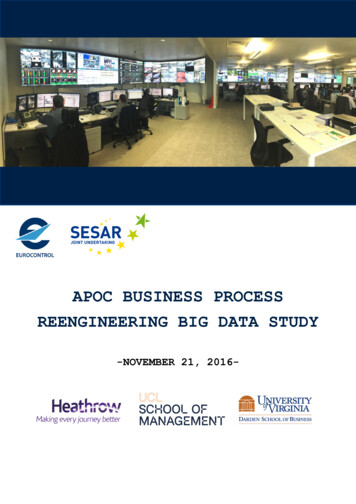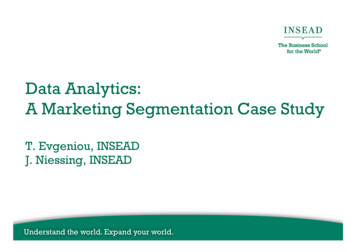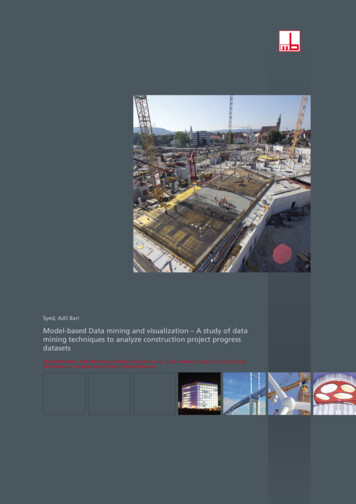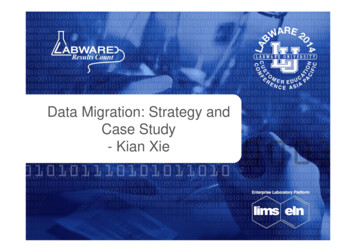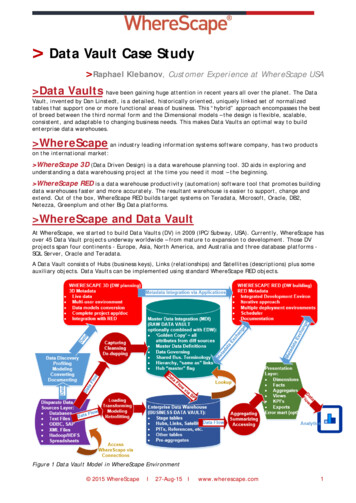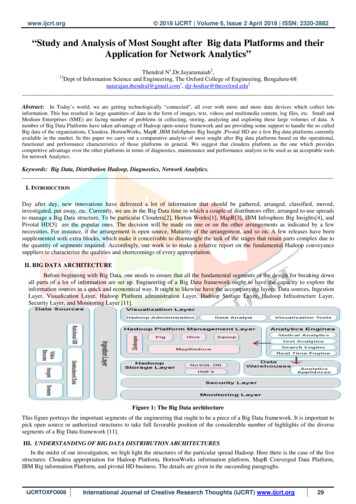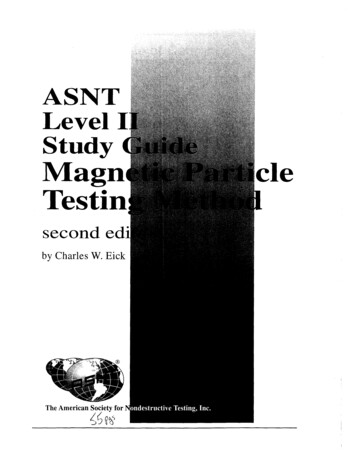
Transcription
ASNTLevel IStudyMagnTestinsecond eby Charles W. EickThe American Society forsSq scle
AcknowledgmentsA special thank you to everyone who helped with the publication of this book, especially thefollowing technical reviewers:William Chedister, Circle Systems, Inc.William Cook, CITS ServicesGerard Hacker, Teledyne Brown EngineeringVll.ma Holmgren, MagnafluxKarl E. Kraft, Kraft Technology ResourcesBill Mooz, Met-L-ChekGeorge Pherigo, PH Diversified, Inc.William Plumstead, Sr., PQT ServicesSam Robinson, Sherwin, IncorporatedThorn Schafer, ManTech SystemsEngineering CorporationKermit Skeie, RetiredD. Scott Sullivan, Rolls-Royce CorporationMichael White, Met-L-ChekCynthia M. LeemanEditorPublished byThe American Society for Nondestructive Testing, Inc.1711 Arlingate LanePO Box 28518Columbus, OH 43228-0518Copyright 2003 by the American Society for Nondestructive Testing, Inc. All rights reserved.ASNT is not responsible for the authenticity or accuracy of information herein, and publishedopinions and statements do not necessarily reflect the opinion of ASNT. Products or servicesthat are advertised or mentioned do not carry the endorsement or recommendation of ASNT.ACCP, IRRSP, Level III Study Guide, Materials Evaluation, NDT Handbook, Nondestructive TestingHandbook, The NDT Technician and www.asnt.org are service marks of the American Society forNondestructive Testing. ASNT, Research in Nondestructive Evaluation and RNDE are registeredtrademarks of the American Society for Nondestructive Testing.ASNT exists to create a safer world by promoting the profession and technologies ofnondestructive testing.Library of Congress Cataloging-in-Publication DataEick, Chuck W ., 1948ASNT level II study guide : magnetic particle testing method I byChuck W. Eick.-- 2nd ed.p.cm.ISBN 1-57117-096-01. Magnetic testing. I. Title: ASNT level two study guide. II. Title:ASNT level 2 study guide. III. Title.TA417.3.E33 2003620.1'1278--dc212003007792Published by the American Society for Nondestructive Testing, Inc.PRINTED IN THE UNITED STATES OF AMERICAfirst printing 05/03ii
Table of ContentsReferences.vChapter 1 - The History of MagneticParticle Testing .1Basic 000000002Chapter 2 - Theory of Magnetism . 5Magnetic DomainsMagnetic PolesTypes of Magnetic MaterialsSources of MagnetismChapter Review 007Chapter 3 - Magnetic Flux Theory .9Magnetic Flux LinesMagnetic Hysteresis CurveFlux LeakageBasic Magnetic Particle Testing TheoryChapter Review 0000000000000000000000 90 000000005000001201300ooo00000000Electrical CurrentsAlternating CurrentHalf Wave Direct CurrentFull Wave Direct CurrentThree Phase Full Wave Direct CurrentCircular Magnetic FieldsField in and Around PartsMethods of Inducing Circular FieldsCircular Magnetic Field StrengthDiscontinuitiesLongitudinal Magnetic FieldsField in and Around PartsMethods of Inducing LongitudinalMagnetic FieldLongitudinal Magnetic Field StrengthChapter Review 003000000000000o32TermsDiscontinuity CategoriesInherent DiscontinuitiesPrimary Processing DiscontinuitiesForging DiscontinuitiesCasting DiscontinuitiesWelding IndicationsSecondary Processing DiscontinuitiesIn Service DiscontinuitiesSurface and SubsurfaceNonrelevant Versus RelevantAcceptance and Rejection CriteriaAids for Indication EvaluationDiscontinuity EvaluationHistory of PartManufacture ProcessPossible CausesUse of PartTolerancesChapter Review 00Chapter 5 - Magnetic Particle TestingParticles .General r 7 - Testing and Evaluation ofIndications .o00o00006Chapter 4 - Electrically InducingMagnetism .1500Standards and SpecificationsPart GeometryPart SizeTypes of DiscontinuitiesSelection of Equipment and EnvironmentDetermination of Field StrengthPart PreparationSequence of OperationsChapter Review Questions0000Chapter 6 - Method SelectionCriteria .020Application MethodsDry ParticlesWet ParticlesChapter Review Questions000000000000000340000 0000o3700000000000o38iii
ASNT Level II Study Guide: Magnetic Particle Testing MethodChapter 8 - DemagnetizationPrinciples .39Residual Magnetism .39Reasons for Demagnetization .39Retentivity and Coercive Force . .40Demagnetization Methods .40Heat Treating Demagnetization . .40Alternating Current Demagnetization . 40Direct Current Demagnetization . .40Electromagnetic Demagnetization . 40Demagnetization Verification Methods . .40Chapter 8 Review Questions . 42Chapter 9 - Magnetic Particle TestingEquipment . .45Stationary Equipment . .45Mobile Equipment . .45Portable Equipment . 45Ultraviolet Light . .46Visible Light . .46Baths . .46Quality Control Factors . .47Chapter 9 Review Questions . .48Appendix 1 - Glossary . .49Appendix 2 - Answer Sheet . .55iv
References1 . Reference ABetz, C.E., Principles of Magnetic Particle Testing, Magnaflux, Chicago, Illinois,1997.2. Reference 8Schmidt, J. Thomas, and Kermit Skeie, technical editors, Paul Mcintire, editor,Nondestructive Testing Handbook, second edition, Volume 6, Magnetic ParticleTesting, the American Society for Nondestructive Testing, Inc., Columbus, Ohio,1989.3. Reference CGeneral Dynamics, Classroom Training Handbook: Nondestructive Testing, MagneticParticle, CT-6-3, second edition, the American Society for Nondestructive Testing,Inc., Columbus, Ohio, 1977.v
vi
Chapter 1The History of Magnetic ParticleTestingThe magnetic particle equipment andtesting processes we use today have a long andinteresting history. In the mid-1800s some of thefirst magnetic particle testing was completedusing natural magnets to test rifle barrels fordefects. From this early testing to today'smodern multidirectional units is a very largestep.Alfred Victor de Forest completed some ofthe first real magnetic particle testing in the late1920s. His early work was the foundation of thetesting methods that are used today andproduced the idea of using current passedthrough a part to produce a magnetic field inthe part. In addition, he developed the processof using magnetic particles to detectdiscontinuities in parts. In the very last part ofthe 1920s Foster B. Doane joined him. Theirwork and vision resulted in the establishment ofthe Magnaflux Corporation.Throughout the 1930s, de Forest and Doanecontinued to develop the magnetic principlesthat are used today. In addition, work inGermany resulted in the development ofmagnetic particles suspended in water beingused to increase the sensitivity of tests.While some of the first applications in the1930s were in the aviation industry, otherindustries were also quickly applying themagnetic particle testing process. Many of theseapplications were driven by the need toimprove safety and reliability. One interestingapplication was the use of magnetic particletests on steering parts of the racecars competingat the Indianapolis Motor Speedway in themid-1930s.It was also during the 1930s that greatstrides were made in developing magneticparticle testing equipment and introducingtraining and technical books on the subject.In the 1940s the world was at war. As isoften the case, wars advance technology at afaster pace and magnetic particle testing was noexception. Production on a mass scale wasnecessary. Several important events occurredduring this period. One was the development ofthe quick break design necessary when testingwith coils. Another development was the use offluorescent magnetic particles. It was alsoduring this time period that training andqualification of personnel became a requirementdue primarily to government manufacturingquality requirements. The training of personnelresulted in some of the first organized trainingclasses being developed and conducted formagnetic particle testing.The 1950s saw the development of magneticparticle testing in many industries. Theaerospace industry was entering an era wherejet engines were beginning to replacereciprocating engines. Whereas the olderreciprocating engines put magnetic particletesting to good use, the newer jet engines withvery high rpm turbine components placedadditional demands for higher quality tests. Inaddition, during this period magnetic particletesting was increasingly being used on new andoverhauled automotive parts, buildings andbridges. In the later part of the 50s, the firstmultidirectional magnetic testing unit wasintroduced. One additional and very importantdevelopment during the 1950s was thepublication of the first edition of theNondestructive Testing Handbook. The handbookwas made up of two volumes and was by farthe most complete document on nondestructivetesting. It remained one of the primaryresources of the nondestructive testing industryfor several decades.The 1960s saw the introduction of trulyportable magnetic testing equipment. Thisequipment was first used in the ship buildingindustry, but quickly became a common piece oftesting equipment at high rise building and1
ASNT Level II Study Guide: Magnetic Particle Testing Methodbridge sites, offshore drilling platforms and onpipelines. This period also saw the introductionof devices, such as quantitative shims, toimprove technique development and the qualityof results. Fluorescent magnetic particle bath inpressurized cans was also introduced.The 1970s and 1980s saw the introduction ofimproved fluorescent particles and the use ofsolid state components in magnetic particleequipment.There have been continuing improvementsin equipment, particles, quality verificationdevices and techniques during the last part ofthe 20th century. And the future holds evenmore opportunities for improvement.This section has provided only a very briefoverview of the history of magnetic particletesting. This overview is based on informationobtained primarily from the referencesidentified below. Readers who wish to furtherexpand their knowledge of the rich history ofmagnetic particle testing should review thefollowing references:A. Chapter 1B. Section 3, Parts 1 and 2Basic ProcedureThe magnetic particle testing process is notcomplicated. Most technical publications statethat the only process requirements are theapplication of the field, application of particlesand testing of the part. Whereas this is basicallytrue, every Level II technician knows that thereare usually several more steps required.Therefore, it could be said that the basic stepsfor a magnetic particle test are:1. precleaning of the part;2. application of the magnetic force toestablish the field in the part;3. application of the particles to detect any fluxleakage;4. testing of the part;5. demagnetization of the part;6. postcleaning of the part.The amount of precleaning is directlydependent on the process application andsensitivity required. For example, underwatertesting does not require the degree ofprecleaning that a jet engine turbine partrequires.Application of the magnetic field is a mustfor the test. The method and number of shotscan vary from part to part, but a field must beestablished.2Application of the particles is a processrequirement, however, the process could requiredry particles or wet fluorescent particles. Inaddition, the application method could beresidual or continuous.The testing of the part is basically a visualinspection, though it could be automated. Inaddition, the process may require white light orultraviolet light.Demagnetization of the part is required bymost standards. However, if the part will beheat treated in the next manufacturing stage,demagnetization might not be required.Postcleaning of parts is normally required.However, an additional step to the postcleaningcould be preventive corrosion treatment.While the basic magnetic particle process isnot complicated in theory, the application of theprocess can involve many additional steps. It isimportant that the Level II technicianunderstand the procedure or processspecification he or she is working under toensure that all steps are followed.ReferencesAB.Chapter 2Section 1, Part 1AdvantagesSome advantages of magnetic particletesting are:1. sensitivity to detecting very fine surfacecracks and near surface discontinuities inferrous metals;2. portability for field use;3. relatively simple and inexpensive toperform;4. can be performed on thinly coated, paintedor plated parts;5. process can be automated;6. training of personnel is not complicated orexpensive.LimitationsSome limitations for magnetic particletesting are:1. can be used only on ferrous metals;2. magnetic field and discontinuity orientationis critical;3. postcleaning of parts may
Karl E. Kraft, Kraft Technology Resources Bill Mooz, Met-L-Chek George Pherigo, PH Diversified, Inc. Cynthia M. Leeman Editor Published by William Plumstead, Sr., PQT Services Sam Robinson, Sherwin, Incorporated Thorn Schafer, Man Tech Systems Engineering Corporation Kermit Skeie, Retired D. Scott Sullivan, Rolls-Royce Corporation Michael White, Met-L-Chek The American Society for .
